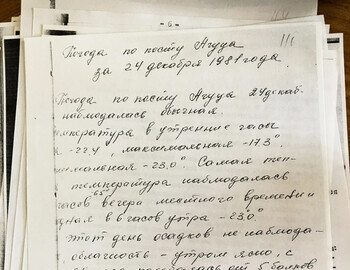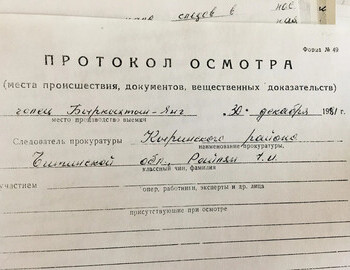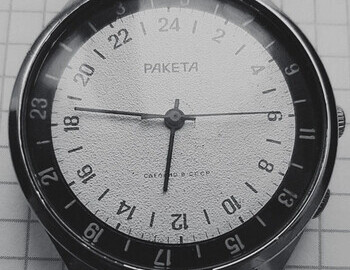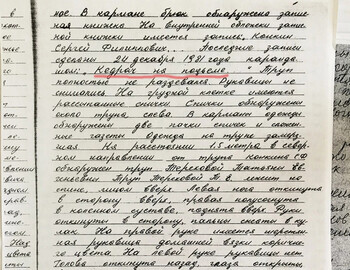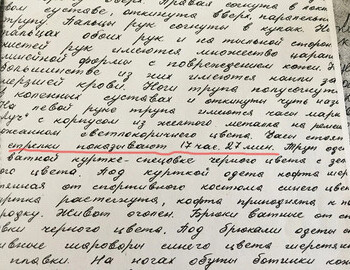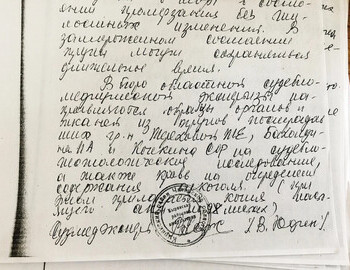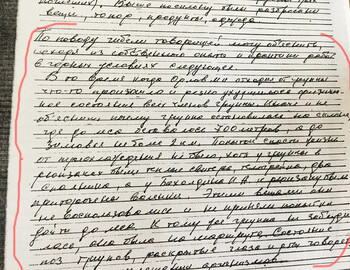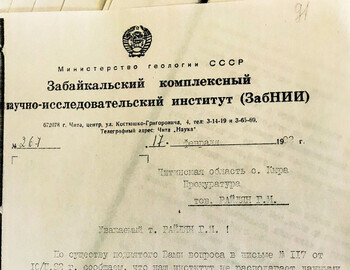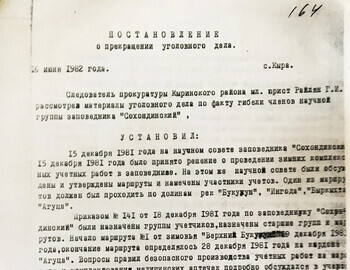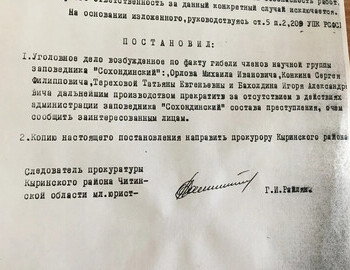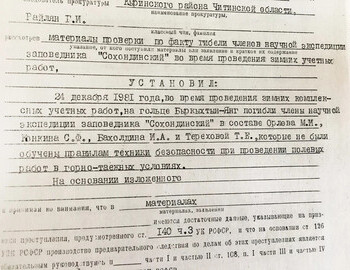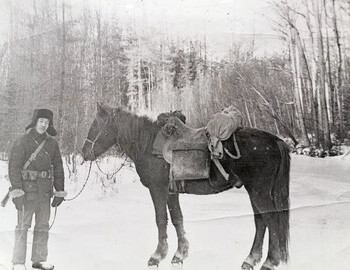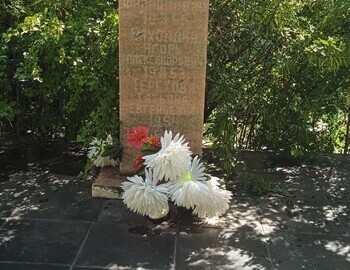
Sokhondo Nature Reserve: The Trans-Baikal Dyatlov Pass
Strange poses and matches on the chest. The mystery of the death of reserve employees
October 5, 2023. All rights reserved Komsomolskaya Pravda. Author Natalya Varsegova

The village of Kyra is located 60 km from the reserve. Photo: Natalya Varsegova
This terrible story happened on Christmas Eve, 1982. On December 24, four workers of the Sokhondo Nature Reserve died in the remote taiga: junior researcher Mihail Orlov (25), laboratory assistant Sergey Konkin (24), forester Igor Baholdin (28) and his common-law wife Tatyana Terehova (27).
Searchers will find three bodies three days after their deaths, and they will continue searching for the last body for almost two weeks.
- Three were lying on their backs with their arms and legs raised, their eyes open, matches scattered on their chests, recalls Pyotr Baranov, who found the bodies of the dead. - The fourth was buried in the snow. They were only two kilometers away from the nearest winter shelter.
No one knows for sure what happened that day. So they dubbed this story the Trans-Baikal Dyatlov Pass, comparing it with the mysterious death of nine hikers in the mountains of the Northern Urals in 1959.
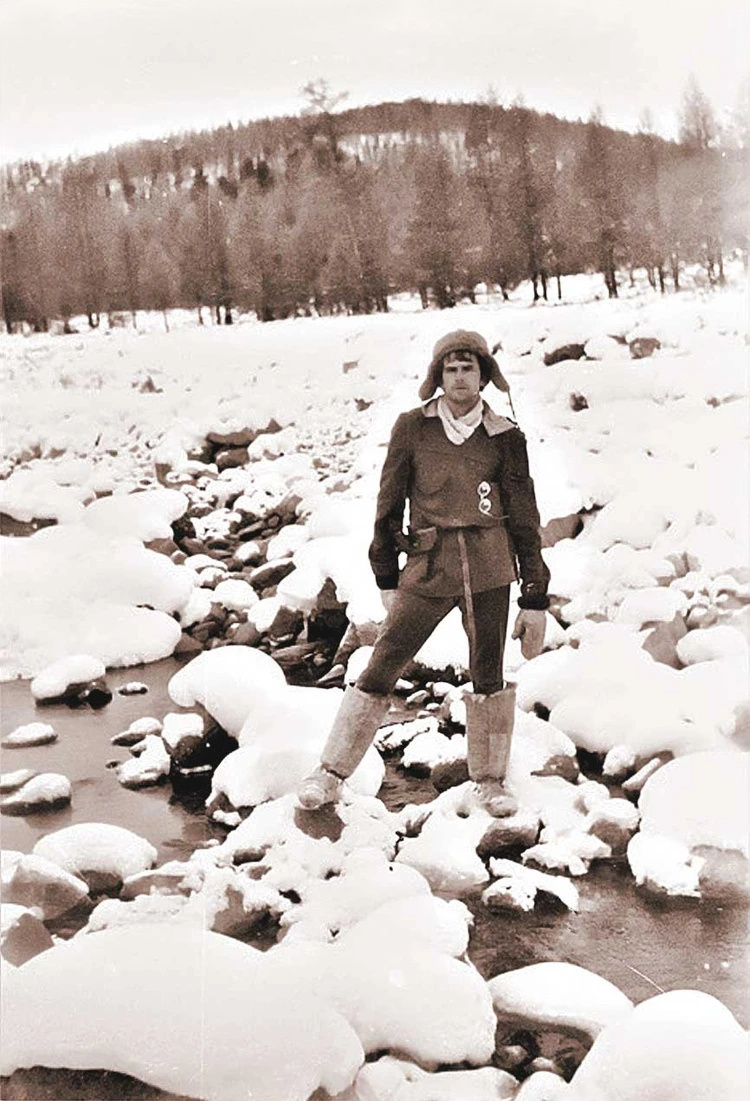
Pyotr Baranov lived: he was in the first census group. Photo from that same route.
- 2 -
Scientific party
The Sokhondo Nature Reserve is a distant place. More than six hours flight from Moscow to Chita, then almost 8 hours (420 km) by minibus along a rough road to the village of Kyra, from there 60 km to the border of the protected area.

Route. Photo: Aleksey Stefanov
The uniqueness of the Sokhondo Nature Reserve is in its location. Loach (meaning "bare hill without vegetation" - Ed.) Sokhondo, after which the reserve is named, is a continuation of the Yablonovy Ridge, separating Siberia from the Far East. The landscapes of the ridge are steppes, forest-steppes, taiga, mountain taiga, mountain tundra. Each altitude zone has its own plants and animals. Sokhondo (2504 m) is an ancient volcano, which adds to the attractiveness of these places. In addition, the territory of the reserve is a global watershed, from here the rivers flow into two ocean, the Pacific and the Arctic.
In the late 70s - early 80s, the reserve was the center of scientific life.
- Director, Candidate of Biological Sciences Andrey Vasilchenko gathered a unique scientific group, says Pyotr Ulybin, a former conservation engineer for the reserve. - Specialists from all over the country. My wife and I came from Irkutsk in 1982, after graduating from the Agricultural Institute. We were immediately offered a choice of housing, a job, and a kindergarten for our daughter. In Soviet times these were luxurious conditions.
Animals were counted by their tracks
Mihail Orlov first came to the Sokhondo Nature Reserve in 1980 for practical training as a student at the Faculty of Biology at Gorky University. Then he was invited to work here.
Mihail arrived with his wife Valya; the couple had no children. He settled next to the reserve administration in the village of Kyra. In the regional center, where there are now less than 4,000 people, in the early 80s there lived a thousand more.
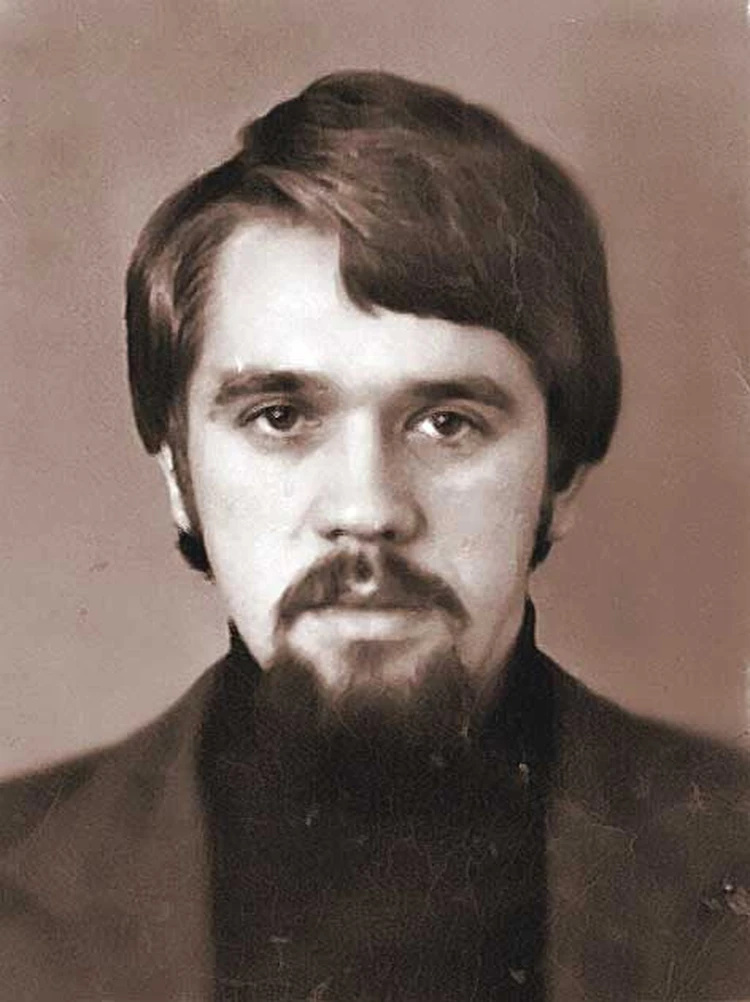
Mihail Orlov. Photo: Archive of the Sokhondo Nature Reserve
Mihail Orlov worked at the reserve for two years, so his photo was kept in his personal file. There are no photographs left of the remaining victims.
- There was almost nothing here, food was tight, and other goods too," recalls Peter Ulybin’s wife Lyubov. "The first year I almost cried when I saw what a hole we found ourselves in." Then we got used to it and got carried out by the work...
In 1981, Orlov invited a friend here, a graduate of the biology department of Gorky University, Sergey Konkin. He got a job in the scientific department, one of whose tasks was to count animals. In those years it was held twice a winter. Before hunting in December and after - in February.
- 3 -
The accounting was organized like this. Two groups set out on the route. The first one laid out a ski track and counted all the animal tracks along the way, crossing them out in the snow. A day later, a second group followed their route and counted fresh tracks. Then, using formulas, average indicators were derived.
From the interrogation of the director of the reserve Andrey Vasilchenko: "At the scientific council on December 15, 1981, it was decided to carry out complex winter census work along two routes. One of them: Upper Bukukun - Ingoda - Agutsa. Starts on December 19, ends on December 28. On December 18, all participants in the counting work were delivered to their starting points. In the first group were Vasilchenko and laboratory assistant Baranov, in the second are Orlov and Konkin."
Sergey Vasilchenko, the son of the director of the reserve, then worked as a forester. Pyotr Baranov was an employee of the scientific department. The people were experienced, hardy, and well acquainted with the taiga. That's why they were assigned to the first group to lay ski tracks through the snowdrifts. Orlov and Konkin, less prepared, had to follow their trail. All treks were taking place at daytime - from a winter hut to another winter hut, where overnight stays were planned.
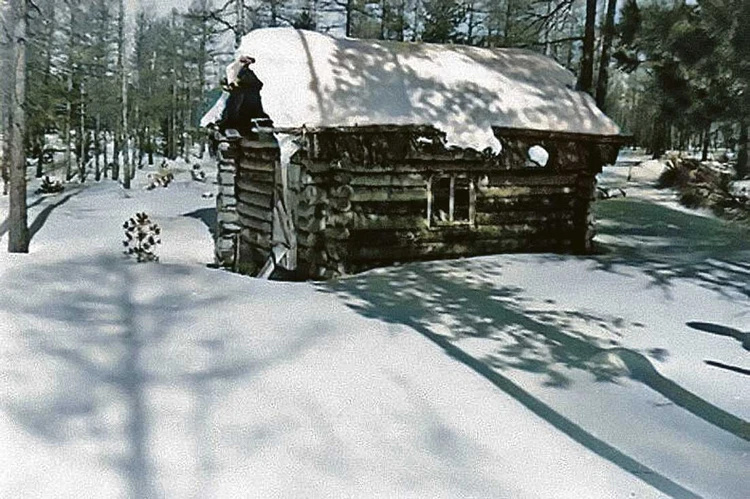
This is what the winter hut looked like, where the census takers stopped for the night. Photo: Archive of Peter Baranov
The sensing worked
- Strange things began while we were driving in the UAZ to the starting point,- says Pyotr Baranov. - A forester was assigned to each group to accompany them. I walked with Seryoga Vasilchenko. And Orlov and Konkin had to go with Shelomeytsev. But on the way he suddenly rebelled. I won’t go on the route - that’s all! Seryoga tried to calm him down, word for word, it came to a fight. And when we got there, Shelomeytsev jumped out of the car and ran away. We never understood what happened to him. Didn't explain anything! And after the tragedy he said: "I would have been the fifth to die. I could feel it."
From the dropping site to the starting point of the route, Upper Bukukun, is about three kilometers by ski. It was then that it became clear that Orlov and Konkin were not ready for the taiga.
- Konkin was physically weak and tired quickly,- continues Pyotr Baranov. - They also walked in padded jackets, but you can’t do that." From sweat they become heavier and become a burden. Vasilchenko and I moved around in cloth jackets that accumulates less moisture. When they arrived at the winter quarters, Konkin was literally wringing out the sweat from his padded jacket. The next morning, Seryoga and I set out on the route; we had to walk 12 km in knee-deep snow. It was hard, the skis were falling through, the snow was loose. It is much easier for the second group to follow us. During the night the ski track became harder from freezing.
Taiga novel
Igor Baholdin and Tatyana Terehova met and fell in love with each other in the zone, somewhere in the Trans-Baikal steppes. He is a police dog breeder, she is an accountant. Both had their own family background. And therefore, as the rumor goes, colleagues looked at their romance with grins. This forced them to go to the taiga cordon of the Sokhondo Nature Reserve in September 1981, where he got a job as a forester, she as his assistant. On New Year's Eve we asked to go home for a few days. Tatyana wanted to spend the holiday with her little son.
From the testimony of the director of the reserve Vasilchenko: "On December 17, the chief forester Yashnov said that on the radio communication forester Baholdin asked permission to leave the Ingod cordon for the New Year together with the second census group. For this they needed two pairs of skis and some food."
- The car brought us to the Golden Key," recalls Viktor Yashnov. Ttwo years ago he retired as director of the reserve. - From there we skied up to the pass and left provisions for Baholdin and Terehova at the Ingoda cordon.
What is a cordon? This is the forester's permanent residence. A good house with a bathhouse on the river bank. Stop line for poachers. If they wander in from the opposite bank of the Ingoda, the forester will stop them. Foresters were also checking the territory and drawing the boundaries of the reserve. They even cut hay for the horses.
The Ingoda cordon was the fourth overnight stop for the census group. By agreement with director Vasilchenko, it was decided that the couple - Igor and Tatyana - would leave together with the second group - Orlov and Konkin.
On December 20, both were healthy and full of strength. They had enough food and equipment.
From the testimony of the director of the reserve Vasilchenko: "On December 22, we received a radio message from forester Bakholdin from the Ingoda cordon that the first group, Vasilchenko and Baranov, had passed the cordon. And on the 24th Orlov and Konkin come out, and with them Baholdin and Terehova."
- The difficulty is that the traverse from Ingoda along the Byrkyktyn-Yang gorge (translated from ancient Turkic - "difficult to cross" - Ed.) was unfamiliar to us, explains Pyotr Baranov. - When we climbed the ridge, a snowstorm began. We literally ran these three kilometers on the crust, taking off our skis. On the descent everything became quiet. We reached the winter hut, spent the night, and the next day we went down with the confidence that the other four were following us. They didn’t even suspect that something was wrong with them.
- 4 -
Wrappers, elastic band, ski
The investigation established that researchers Mihail Orlov and Sergey Konkin, as well as Igor Baholdin and Tatyana Terehova, who joined them, left the Ingoda cordon in the morning. They had to walk 15 km in a day, ten of which were a gentle climb to an altitude of approximately 700 meters. Along the river, then up the stream. It seems easy, but experienced forester and former reserve employee Anatoliy Sakiyaev says that such treks are very exhausting. It’s easier to rise sharply and rest than to crawl uphill for half a day.
The final point of the route was the Aguts cordon, where the first group arrived in the evening of December 25. In a day, the second group of four were supposed to appear here as well.
- But they didn't show up, we waited until the 27th and radioed about the missing guys - recalls Pyotr Baranov.
From the testimony of the director of the reserve Vasilchenko: "A search was organized. I called the first secretary of the district committee, Lyahov, so that they would give us a helicopter. On December 28, Baranov and Vasilchenko found three corpses on the ridge. The incident was reported to the prosecutor's office."
- We climbed the ridge and saw four dusty ski tracks,- continues Baranov. - We followed the ski track. The weather is sunny, my soul is calm. We were sure that nothing bad had happened. Candy wrappers are scattered along the way. Who would care about candy if there was an emergency? Vasilchenko went a little ahead, and I first came across an elastic band from a ski binding, then I saw a ski. It was strange. Suddenly I heard Vasilchenko scream. He rushed towards him, and on the edge of the ridge there were three corpses. They were positioned unnatural. Everyone is on their back, with their arms and legs raised up. There were signs of panic all around - things, dumplings, clothes, a blanket were scattered.
From the incident scene inspection report: "... An unloaded 28-caliber hunting rifle was found, with the butt stuck in the snow with the barrel up. Near the gun there is a wooden pole with notches stuck in the snow. There are also three pairs of skis and open backpacks.
Nearby is Konkin's corpse on his back. The head is tilted back, face up. Eyes covered with snow. The mouth is open. The left arm is bent at the elbow joint towards the stomach. The clock stands at 18 hours 27 minutes. The right hand is parallel to the corpse.
Notebook in trouser pocket. Last entry dated December 24, 1981: "The cedar tree is on the rise." Matches are scattered on the chest. Matches were also found near the corpse on the left.
One and a half meters from Konkin’s corpse is Terehova’s body. On her back, face up. The left leg is tilted to the side, the right leg is half bent at the knee joint, raised up. The arms are thrown to the sides, the fingers are clenched into a fist. The head is thrown back, the eyes are open. There are many linear scratches with damage to the skin on the fingers of the left hand and on the back of the hand. Hours - 17 hours 25 minutes. The jacket is raised to the chest, the lower back is exposed. There are scattered matches on the left cheek of the corpse and on the chest. A meter away from her are trousers, a women's jacket, a wadded blanket. A pair of felt boots and a bag of dumplings. Next to it is a faux fur hat.
26 meters from Konkin and Terehova is the corpse of Baholdin. Lying on his back, slightly on his right side. The head is thrown back. The left arm is thrown upward to the side. The right one is bent at the elbow, tilted up parallel to the corpse. The fingers are bent into fists. There are many linear scratches on the fingers of both hands. There are drops of blood. Legs are half bent at the knees. Clock - 17 hours 27 minutes. The jacket is unbuttoned, the jacket is pulled up to the chin. The belly is exposed."

The entire village saw off the dead on their final journey. Photo: Archive of Pyotr Baranov
"Something happened"
From the testimony of the director of the reserve Vasilchenko: "Orlov was found 600 - 700 meters from the dead a few days later in the forest. He apparently moved away from the group and started the descent to the winter hut. And at this point of time something happened, which caused the physical condition of all members of the group to sharply deteriorate. There is no other way to explain why the group stopped on the slope when there were 700 meters left to the forest and no more than two kilometers to the winter hut. There were no attempts to save themselves from hypothermia, although the group had warm sweaters, padded jackets, and two sleeping bags in their backpacks. The group did not get lost, they were on the route. The state of the corpses' postures, open eyes and mouths indicate a sharp deterioration in the body's condition."
From the protocol of the inspection of the scene of the incident dated January 5: "Orlov’s corpse lies in a hole in the snow on cedar tree branches. The body lies on his left side. A hat next to the corpse. The arms are bent at the elbows. Wrist watch stopped at 19 hours 59 minutes. Legs tucked to the stomach. Padded jacket, scarf, jacket, shirt, trousers, boots. Notebook. Last entry December 24, 1981 at 15:45. Nearby is a backpack."
- Orlov was found by his shoulder sticking out from under the snow, says Anatoliy Sakiyaev. - Things are scattered around: an axe, shirts, a cooking pot, a bag of dumplings, a sleeping bag.
Questions with no answers
It was a very strange death. How and from what did these four die? Why did they lie with their arms and legs raised? Any forensic expert will tell you that people generally do not die in such positions. What do scattered matches on your chest mean?
The Kyrinsky prosecutor's office opened a criminal case. But not because of the violent death, but violation of labor safety rules. And not at the end of December 1981, when the corpses were discovered, but almost four months later.
Why? Did they really want to cover up their tracks and hide the real causes of death? We will try to find some answers.
To be continued.
You can discuss this topic on Dyatlov Pass Forum.


